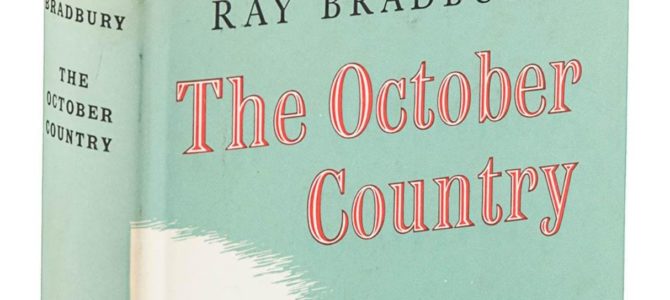
As the leaves fall, many can’t really do the normal Halloween things this year. That is, we can try, but we need to pay attention to the pandemic. The Centers for Disease Control guidelines tell us how to traverse “an open-air, one-way, walk-through haunted forest where appropriate mask use is enforced.” The CDC warns that “If screaming will likely occur, greater distancing is advised. The greater the distance, the lower the risk of spreading a respiratory virus.”
True enough. But what a downer. Maybe just stay home and read some fiction that’s attuned to our autumnal mood. It’s time for scenes out of Norman Rockwell that have been blended with the dark, the uncanny, and the weird. No one makes us scream in the confines of our own homes like Ray Bradbury.
Bradbury, “the gatekeeper to that chimerical underworld known as the October Country,” in the words of his biographer Sam Weller, was a literary wonder in many respects and a commercial wonder in all respects. The Fahrenheit 451 (1953) author must be the most efficient nostalgiac who ever put pen to paper.
Reminiscences of Bradbury’s Waukegan, Illinois boyhood are artistically woven into the writings he contributed to every popular genre: not just science fiction but fantasy, horror, detective stories, and children’s fiction. His lurid yet lovely tales have made him an American classic.
Perhaps the best known gothic fantasy he wrote for children is The Halloween Tree (1972). A bunch of trick-or-treaters are running around the neighborhood, “blown like leaves before a storm,” and they decide to approach the grandly decrepit house on the hill where a strange man lives.
His name is Carapace Clavicle Moundshroud, and he becomes the kids’ Dickensian Christmas Carol-style guide to the ghosts of Halloweens past. This time-traveling and globe-spanning tour of death festivals through the ages is touched off by Moundshroud’s incantation: “World turn! Leaves burn! Grass die! Trees . . . fly!”
The kids learn about how different civilizations have commemorated human beings’ passage to the next world. They also learn about the sacrifices friends selflessly make for one another in times of danger.
Bradbury is the master of the ghoulish twist. Trick-or-treaters normally go knocking on doors dressed as adults—a witch, Frankenstein’s monster, a clown, a phantom—and through the eye-holes of the costume masks shine youthful pairs of eyes. In Something Wicked This Way Comes (1962), it’s the reverse.
One of the protagonists of the novel, Jim Nightshade, notices something fishy about the new kid in town. Jim meets him on Halloween, and is shocked when through “the pink shiny Halloween mask of a small pretty boy’s face,” the eyes of a little old man peer out. “Mr. Cooger, somewhere behind the eye slits, went blink-click with his insect-Kodak pupils.”
Jim and his best friend Will Halloway, joined by Will’s father, do battle with supernatural forces commanded by Mr. Cooger and Mr. Dark, carnival impresarios who have set up their tents on the outskirts of Green Town, Illinois. Evil is finally disabled when Will’s dad takes up a humble hand tool and administers the coup de grace:
Charles Halloway stepped back into the machinery of the merry-go-round, found a wrench, and knocked the flywheels and cogs to pieces. Then he took the boys out and he hit the control box one or two times until it broke and scattered fitful lightnings. . . . He hit the box a last time and threw down the wrench. ‘It’s late. Must be midnight straight up.’
Making their way homeward, the three of them hear the City Hall clock, and the clocks in the church towers of Green Town, all striking twelve midnight. The community is saved.
Sometimes Bradbury leaves his readers satisfied that “the wrong shall fail, the right prevail” in the end (to use Charles Halloway’s quotation of an old folk song). But he doesn’t always. The Bradburian nostalgia and poetry can wrap up cozily—or not.
Take, for example, “The Emissary.” In a time many of us are feeling like shut-ins, this 1955 story seems especially apt. A sickly boy who is not allowed to leave the house finds out what is happening in the world through his dog.
The hound roams far and wide, sniffing and rolling and digging his way around the neighborhood, and runs back home “bringing wind and frost and a smell of apples turned to cider under trees.” Embedded in his curly coat, the dog carries in “goldenrod, dust of farewell-summer, acorn-husk, hair of squirrel, feather of departed robin, sawdust from fresh-cut cordwood, and leaves like red coals shaken from a blaze of maple trees.”
What the dog brings home to this lonely boy at the end will chill your blood. This is a horror story, after all—scary, morbid, and drenched in the sad knowledge of our own mortality.
No one quite catches the light and the dark of this season, and the light and dark in our souls, quite like Ray Bradbury.









